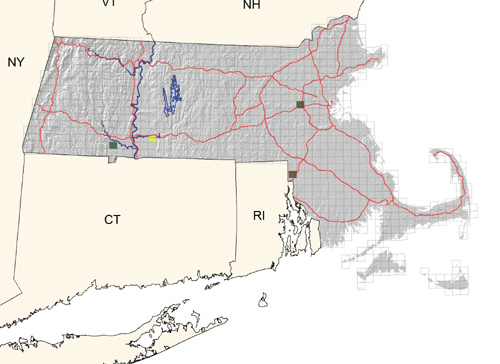Breeding Bird Atlases (BBA)
Find a Bird - BBA1
Breeding Bird Atlas 1 Species Accounts
Red-bellied Woodpecker
Melanerpes carolinus
Egg Dates
April to June
Number of Broods
one or two; may relay if first attempt fails

The Red-bellied Woodpecker is gradually becoming a resident of Massachusetts woodlands, but it has not yet become as thoroughly established as other southern birds such as the Northern Cardinal, Tufted Titmouse, and Northern Mockingbird. Although occasional vagrants have appeared since the mid-1800s, the species has been gradually expanding its range in the northeastern states. Red-bellied Woodpeckers increased in southeastern New York during the mid-1960s and were first recorded nesting in Connecticut in 1971.
The growing number of sightings in Massachusetts led observers to suspect that the birds were breeding, and the first state confirmations occurred during the Atlas period in 1977 in Natick and North Attleboro and then in Westfield and Southwick the following year. Although the species is still a fairly rare and local resident, the number of reports has continued to increase, especially during the winter when the birds visit feeding stations.
The Red-bellied Woodpecker is a resident species, but some individuals may move long distances, and there is some postbreeding dispersal. Males tend to remain on or near the nesting territory year-round while the females move to a new area to establish a separate winter territory. The Red-bellied Woodpecker is often found in river bottomland forest, but it frequents a variety of other habitats including pine barrens, upland forests, farmland, small woodlots, and even shade trees in towns and city parks.
This woodpecker is a noisy species with a variety of vocalizations. Common calls include a series of chuf-chuf-chuf or cherr-cherr-cherr sounds, a rolling qui-er-r-r-r-r, and a crirrk, the latter similar to one of the flicker’s notes. Both sexes also communicate by tapping and drumming on a trunk or limb to indicate territory.
In Massachusetts, nesting generally begins in April or May. Both sexes work on excavating a nesting cavity in a tree, stump, telephone pole, or fence post. Although dead snags or live trees with softwood (such as Cottonwood) are preferred, a variety of tree species may be utilized. The Southwick nest was in a live Sugar Maple in heavy forest (Kellogg). It takes an average of 7 to 10 days for the birds to complete the cavity. Sometimes an old nest is reoccupied or the abandoned hole of another species of woodpecker is used. Typical nesting cavities have an opening 2 inches in diameter, are 10 to 12 inches deep, and are located from 5 to 70 feet above the ground.
Three to eight (average four to five) white eggs are laid, and a lost clutch usually results in another nesting attempt. Older sources give the incubation period as 14 days, but 11.5 to 12 days is now believed to be typical. Both sexes share incubation, the male by night and the female doing the larger share during the day. The altricial and naked nestlings are fed by both parents and are brooded for at least one week. At 24 to 26 days of age, they have acquired their juvenal plumage, which somewhat resembles that of the adult female, and are ready to fledge. The young remain close to the nesting cavity for the first several days before following their parents farther afield. In Natick, two fledglings accompanied the adults to a suet feeder in May. The following year (1978), the pair incubated from May 6 to May 17 and was observed until May 28. At the Southwick nest, one nestling was nearly ready to fledge on May 23. In North Attleboro, a male was observed feeding nestlings on July 3. Two broods may be raised in more southerly states, but this is less frequent in the northern parts of the range. Here, the later nesting dates probably represent renesting attempts. There is often competition for nest cavities, and the site in Natick was eventually surrendered to invading starlings. The immatures are independent at about 42 days of age. They gradually attain adult plumage. The adults have a complete molt at the end of the summer.
Red-bellied Woodpeckers forage in trees and on the ground. Although there are seasonal variations, the diet is about 26 percent insects and other invertebrates and 74 percent mast, seeds, and berries. These birds have the habit of storing food by wedging it into cracks in bark or other crevices.
After the nesting season, some Red-bellied Woodpeckers remain to winter near the nest sites, and others disperse to new locations. Winter sightings are frequently at feeders, where the birds take suet, cracked corn, and sunflower seeds.
Map Legend and Data Summary
Atlas 1 data collected from 1975-1979


Note: rare in southern Connecticut River valley; recent dramatic increase practically statewide
Helen C. Bates



